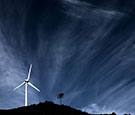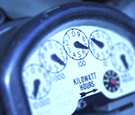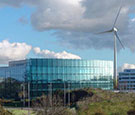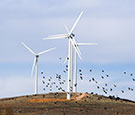

Frequently asked questions
 If Coriolis Energy or another wind farm developer are proposing a wind farm near to where you live it is very natural to have a lot of questions. As part of any development we try to answer all these at a series of public exhibitions before a planning application is submitted, however some of the more common questions we get asked, together with our answers, are covered here.
If Coriolis Energy or another wind farm developer are proposing a wind farm near to where you live it is very natural to have a lot of questions. As part of any development we try to answer all these at a series of public exhibitions before a planning application is submitted, however some of the more common questions we get asked, together with our answers, are covered here.
| 1. | How much of our renewable energy is provided by wind? more» |
| 2. | Is wind energy reliable? more» |
| 3. | Does wind energy need ‘back up’ from other electricity generating sources? more» |
| 4. | What is the capacity factor of a wind turbine? more» |
| 5. | Will my electricity bills be higher? more» |
| 6. | How long does it take to pay back the energy used to manufacture a turbine? more» |
| 7. | What are the potential health effects of wind farms? more» |
| 8. | How noisy are wind farms? more» |
| 9. | Do wind farms harm birds or other wildlife? more» |
| 10. | Do wind farms reduce house prices? more» |
| 11. | How much support is there for wind farms? more» |
| 12. | What is the future for wind energy and other renewables? more» |
1. How much of our renewable energy is provided by wind?
Nearly a quarter of renewable electricity is currently generated by wind energy. Other sizeable contributions are made from hydro, landfill gas and co-firing biomass in power stations.
The British Wind Energy Association (BWEA) tracks the number of wind farms and their capacity for electricity generation. According to these figures, over 1,900 wind turbines had been installed by the beginning of 2008 with a combined capacity of 2,320 MW, generating enough electricity for approximately 1.3 million homes.
On average a single modern wind turbine will generate enough electricity to meet the needs of more than a thousand homes over the course of a year, taking into account the fluctuations in wind speed.
2. Is wind energy reliable?
 As the fuel for wind-generated electricity, the strength, presence, absence, and variability of the wind determines not only how much electricity can be generated but also how reliable electricity from the wind will be in meeting electricity demand patterns.
As the fuel for wind-generated electricity, the strength, presence, absence, and variability of the wind determines not only how much electricity can be generated but also how reliable electricity from the wind will be in meeting electricity demand patterns.
Recently some work was undertaken by the Environmental Change Institute at Oxford University into the availability of wind energy in the UK. The report, commissioned by the Department of Trade and Industry (now BERR) analysed hourly wind speeds collected by the Met Office at 60 locations across the UK between 1970 and 2003.
The study used these extensive wind records to identify patterns of wind power availability across the UK. It found that:
- Wind power availability is greater during winter than at other times of the year, and is on average stronger during the day than overnight
- Wind power delivers around two and a half times as much electricity during periods of high electricity demand as during low demand periods
- the recorded capacity factor for onshore wind turbines in the UK is around 27% - this is higher than that recorded in Denmark or Germany, and emphasises the need to use UK data in wind power assessments.
It concluded that there are distinct advantages of wind turbines being located in a range of locations, rather than being concentrated in one place. The advantage of a diversified system over a highly concentrated system is that the wind turbines are exposed to a range of wind conditions in different parts of the UK.’ In effect, the impact of low wind speeds in any particular area can be smoothed by the generation in other parts of the UK.
3. Does wind energy need ‘back up’ from other electricity generating sources?
The report by the Environmental Change Institute at Oxford University mentioned above also discussed potential impacts of the variability of wind energy generation upon the UK electricity network. It reported that:
- The development of wind power will result in a reduced need for conventional capacity – with wind power supplying 10% of UK electricity, around 3GW of conventional plant could be retired;
- The cost of balancing wind power variability is expected to reduce with improvements in wind power forecasting techniques.
It is sometimes questioned whether wind energy, for example, reduces carbon dioxide emissions because the intermittent nature of its output means it needs to be backed up by fossil fuel plant. A report from the UK Energy Research Centre published in 2006(i) stated that ‘it is unambiguously the case that wind energy can displace fossil fuel-based generation, reducing both fuel use and carbon dioxide emissions’.
| (i) | ‘The Costs and Impacts of Intermittency: An assessment of the evidence on the costs and impacts of intermittent generation on the British electricity network’ (2006) |
4. What is the capacity factor of a wind turbine?
 A ‘capacity factor’ of conventional and renewable generation alike indicates what proportion of the maximum theoretical electricity generation has been (or is likely to be) achieved in reality. So a generator with a high capacity factor is being utilised at close to its maximum theoretical output. The capacity factor of a wind farm is not a measure of efficiency.
A ‘capacity factor’ of conventional and renewable generation alike indicates what proportion of the maximum theoretical electricity generation has been (or is likely to be) achieved in reality. So a generator with a high capacity factor is being utilised at close to its maximum theoretical output. The capacity factor of a wind farm is not a measure of efficiency.
There are many reasons why generating plant operates at less than 100% capacity factor. For conventional plant this could include requirements for maintenance periods, faults or generation not being required from the plant due to variations in consumer demand.
For wind turbines specifically, the capacity factor provides a measure of the amount of electricity generated compared with what could be generated under ideal wind conditions.
Capacity factor is not a measure of the amount of time a generator is running, though it is often quoted incorrectly as being so. The Environmental Change Institute report states that ‘In the UK, a typical wind turbine will generate some electricity for 80 – 85% of all hours in the year’, however the generator may not be running at full capacity for this period, hence the capacity factor being of the order of 27% for wind farms in the UK.
The selection of the appropriate make and model of turbine (in particular the rotor diameter of the turbine) as well as the design of the wind farm site to match the spacing requirements of such turbines has a very significant bearing on the energy production of a wind farm.
5. Will my electricity bills be higher?
 A small increase in the cost of electricity is likely to result from wind power development – this would be equal to around 2.5% of the average domestic cost of electricity with 10% wind power.
A small increase in the cost of electricity is likely to result from wind power development – this would be equal to around 2.5% of the average domestic cost of electricity with 10% wind power.
Wind energy is fast becoming a very competitive source of energy generation. A study published in Wind Power Monthly “Wind Becomes Respectable” (Jan 04) confirmed that wind is cheaper than nuclear and already competing with coal, being “cheaper to exploit at large scale than any of the other renewable energy source”. In some regions it is even noted as being competitive with gas-fired generation.
6. How long does it take to pay back the energy used to manufacture the turbine?
The average wind farm will pay back the energy used in its manufacture within 6.6 and 9 months of operation(i). A modern wind turbine is designed to operate for more than 20 years and at the end of its working life, the area can be restored at low financial and environmental costs. Wind energy is a form of development which is essentially reversible – in contrast to fossil fuel or nuclear power stations.
| (i) | Milborrow, Quick emissions payback for multi-MW turbines, as published in Windstats, vol 18, no. 3 (Summer 2005) |
7. What are the potential health effects of wind farms?
Some people opposed to wind energy have claimed that ‘low frequency noise’ or ‘infrasound’ could be produced by wind turbines, and that this could lead to health issues. However, ‘Low frequency noise and vibrations at a modern wind farm’ (ETSU W/13/00392/REP), commissioned by the DTI in 1997, comprehensively assessed the vibrations from wind turbines. It concluded that overall, modern wind turbines emit negligible amounts of low frequency noise.
8. How noisy are wind farms?
 People are usually surprised at how quiet modern wind turbines are. Sound emitted from a wind turbine will blend into background noise and decrease in relation to the distance from the tower. Even when the wind speed increases, it is often difficult to detect any increase in turbine sound above the increase in normal background noise levels caused by the wind for example wind in the trees.
People are usually surprised at how quiet modern wind turbines are. Sound emitted from a wind turbine will blend into background noise and decrease in relation to the distance from the tower. Even when the wind speed increases, it is often difficult to detect any increase in turbine sound above the increase in normal background noise levels caused by the wind for example wind in the trees.
Wind farm developers are required to carry out detailed noise assessments and comply with rigorous noise standards designed to ensure that the amenity of the rural community is protected. The best advice for any doubters is to go and hear for themselves - a map of currently operational wind farms is available on the BWEA web site.
9. Do wind farms harm birds or other wildlife?
 The RSPB stated in its 2004 information leaflet ‘Wind farms and birds’(i) that “in the UK, we have not so far witnessed any major adverse effects on birds associated with wind farms”. Wind farms are always subject to an Environmental Impact Assessment. Coriolis Energy follows best practice guidelines and work closely with organisations such as Natural England and the RSPB to ensure that wind farm design and layout does not interfere with sensitive species or wildlife designated sites. Furthermore a report published in the journal ‘Nature’ confirmed that the greatest threat to bird populations in the UK is climate change(ii).
The RSPB stated in its 2004 information leaflet ‘Wind farms and birds’(i) that “in the UK, we have not so far witnessed any major adverse effects on birds associated with wind farms”. Wind farms are always subject to an Environmental Impact Assessment. Coriolis Energy follows best practice guidelines and work closely with organisations such as Natural England and the RSPB to ensure that wind farm design and layout does not interfere with sensitive species or wildlife designated sites. Furthermore a report published in the journal ‘Nature’ confirmed that the greatest threat to bird populations in the UK is climate change(ii).
| (i) | RSPB (2004) Information leaflet on Wind Farms and Birds |
| (ii) | Extinction risk from climate change, Nature 427, 145-148 (08 Jan 04) |
10. Do wind farms reduce house prices?
 A small number of studies have been conducted to try and answer this question, and the results have varied greatly with no substantive evidence between a positive effect, no effect at all and a negative effect.
A small number of studies have been conducted to try and answer this question, and the results have varied greatly with no substantive evidence between a positive effect, no effect at all and a negative effect.
The most recent study was the 2007 survey by Royal Institute of Chartered Surveyors (RICS), and Oxford Brooks University. It found there was no clear relationship between the proximity of wind farms and property prices. They found that there is evidence to suggest that the “threat” of a wind farm may have a more significant impact that the actual presence of one. Even this may not translate into lower house prices if the community are actively involved in the process.
11. How much support is there for wind farms?
Over the last 15 years more than 60 separate wind farm surveys have been carried out by different organisations. The results have shown a consistently high level of support for wind farms with an average of between 70-80%. Some of these surveys include responses from residents living near built wind farms.
Various surveys have also been carried out to investigate the impacts on tourism. A survey carried out by MORI Scotland in 2002(i) showed 91% of those questioned would not be put off revisiting an area if wind farms were present and that 80% would be interested in visiting a wind farm if it was accessible to the public.
| (i) | ‘Tourist Attitudes towards Wind Farms’ conducted for Scottish Renewables Forum and British Wind Energy Association |
12. What is the future for wind energy and other renewables?
 Wind turbines, both on and offshore are expected by the Government to provide the majority of the renewables capacity by 2010. Indeed the British Wind Energy Association predict that there will be some 6,000 megawatts (MW) of onshore wind energy capacity delivering nearly 5% of projected energy supply in the UK by 2010(i). The Sustainable Development Commission (SDC) and the Department of Business Enterprise and Regulatory reform (BERR) consider that wind energy is the only economically viable and scaleable technology and that it will be the key renewable energy technology out to at least 2020. Onshore wind power is currently economically viable in many locations across the UK.
Wind turbines, both on and offshore are expected by the Government to provide the majority of the renewables capacity by 2010. Indeed the British Wind Energy Association predict that there will be some 6,000 megawatts (MW) of onshore wind energy capacity delivering nearly 5% of projected energy supply in the UK by 2010(i). The Sustainable Development Commission (SDC) and the Department of Business Enterprise and Regulatory reform (BERR) consider that wind energy is the only economically viable and scaleable technology and that it will be the key renewable energy technology out to at least 2020. Onshore wind power is currently economically viable in many locations across the UK.
Co-firing is likely to reduce in the future due to the likely closure of some coal fired power stations which are currently also co-firing biomass. The potential for hydro and landfill gas has substantially been realised and there is little opportunity for future growth. As other sources of clean energy such as wave and tidal power demonstrate their practical value and become more commercially viable, they may become more important in the energy mix(ii), however until that time energy from wind is essential if we are to try and combat the effects of climate change.
| (i) | British Wind Energy Association, March 2006, Onshore wind; Powering Ahead |
| (ii) | Technologies such as marine technologies have potential around the UK, however constraints such as uncertain costs, early stage of development and remote and hostile environments currently restrict deployment |
